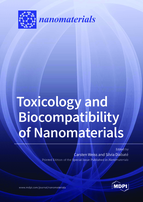Toxicology and Biocompatibility of Nanomaterials
A special issue of Nanomaterials (ISSN 2079-4991). This special issue belongs to the section "Biology and Medicines".
Deadline for manuscript submissions: closed (25 June 2020) | Viewed by 32384
Special Issue Editors
Interests: nanotoxicology; nanomedicine; molecular toxicology
Special Issues, Collections and Topics in MDPI journals
Interests: nanotoxicology; nanomedicine; molecular toxicology
Special Issue Information
Dear Colleagues,
As the understanding of materials at the nanoscale and the ability to control their structure improves, a wide range of nanoparticles (NPs) with novel characteristics and applications are fabricated for, e.g., electronics, engineering and, more recently, in biomedical research. Although the technological and economic benefits of NPs are obvious, concern has also been raised that the very same properties, which open a variety of novel applications, might have adverse effects if such material is inhaled, ingested, applied to the skin or even released into the environment. These concerns have led to an increasing discussion worldwide about possible regulatory policies for NPs. Therefore, there is clearly the need to establish convincing scientific knowledge to assess the impact of NPs on human health and the ecosystem. These questions can only be tackled by collaborative research at the interface of engineering, physics, chemistry, toxicology, and biology.
This Special Issue will cover research in the field of nanotoxicology with a special interest in molecular mechanism of action as well as the safe-by-design concept, i.e., the synthesis of biocompatible nanomaterials. Further, the impact of the bio-corona, that is, the interaction of biomolecules with the NP surface, on toxicity and biocompatibility will be addressed. We welcome submission of reviews, original research articles, and communications.
Dr. Carsten Weiss
Dr. Silvia Diabaté
Guest Editors
Manuscript Submission Information
Manuscripts should be submitted online at www.mdpi.com by registering and logging in to this website. Once you are registered, click here to go to the submission form. Manuscripts can be submitted until the deadline. All submissions that pass pre-check are peer-reviewed. Accepted papers will be published continuously in the journal (as soon as accepted) and will be listed together on the special issue website. Research articles, review articles as well as short communications are invited. For planned papers, a title and short abstract (about 100 words) can be sent to the Editorial Office for announcement on this website.
Submitted manuscripts should not have been published previously, nor be under consideration for publication elsewhere (except conference proceedings papers). All manuscripts are thoroughly refereed through a single-blind peer-review process. A guide for authors and other relevant information for submission of manuscripts is available on the Instructions for Authors page. Nanomaterials is an international peer-reviewed open access semimonthly journal published by MDPI.
Please visit the Instructions for Authors page before submitting a manuscript. The Article Processing Charge (APC) for publication in this open access journal is 2900 CHF (Swiss Francs). Submitted papers should be well formatted and use good English. Authors may use MDPI's English editing service prior to publication or during author revisions.
Keywords
- nano(eco)toxicology
- nanomedicine
- biocompatibility
- bio-corona
- toxicity pathways







